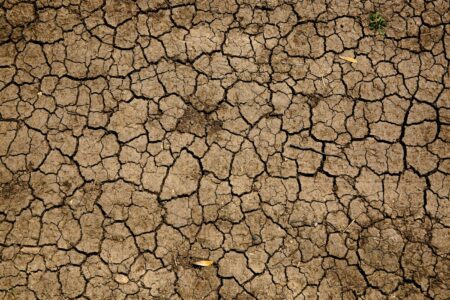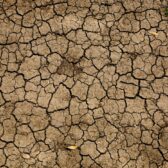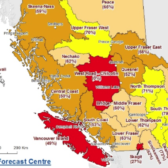Faster, Higher, Stronger
t is becoming increasingly clear that each of us is in training for the climate change Olympics. Our performance will dictate the severity of the consequences of global warming.
In his recent review of Elizabeth Kolbert’s latest book – The Sixth Extinction: An Unnatural History – Globe and Mail science reporter Ivan Semeniuk writes: “Simply by going about our daily business, we’re rewiring the ecological circuitry of the planet, and triggering blackouts aplenty.”
Life-as-usual has serious side effects.
Intergovernmental Panel on Climate Change scientists – who have been warning us about this phenomenon for decades – said in a recent report:
“Continued emissions of greenhouse gases will cause further warming and changes in all components of the climate system. Limiting climate change will require substantial and sustained reductions of greenhouse gas emissions.”
Jennifer Francis told the Chicago-held annual meeting of the American Association for the Advancement of Science on February 15th that a warming Arctic may be to blame for a meandering jet stream that is changing weather patterns.
Temperatures in the Arctic have been rising two to three times faster as elsewhere on Earth.
Francis, a professor at Rutgers University’s Institute of Marine and Coastal Sciences, first published her hypothesis in a paper in the March 2012 online edition of Geophysical Research Letters.
“The temperature difference between the Arctic and lower latitudes is one of the main sources of fuel for the jet stream; it’s what drives the winds. And because the Arctic is warming so fast, that temperature difference is getting smaller, and so the fuel for the jet stream is getting weaker,” Francis said. “When it gets into this pattern, those big waves tend to stay in the same place for some time. The pattern we’ve seen in December and January has been one of these very wavy patterns.
“We can expect more of the same and we can expect it to happen more frequently,” Francis said in the Chicago panel discussion on Arctic change.
Her hypothesis is certainly plausible, although some scientists say more study is needed.
Extreme weather comes at a cost
Australia has just experienced its hottest year ever with record-breaking heat waves and brush fires. Argentina had one of its worst-ever heat waves in December, and parts of Brazil had record rainfall, floods and landslides.
In North America, blizzards and ice storms have brought record-low temperatures much farther south than normal. Yet California has just declared a drought emergency after years of little to no rain. In the United Kingdom, a relentless series of storms have dumped record amounts of rain and caused disastrous flooding.
“In 2012 we had the second wettest winter on record and this winter is a one in 250-year event. If you keep throwing the dice and you keep getting sixes then the dice are loaded. Something is going on,” UK Opposition Labour Leader Ed Miliband told the Observer newspaper in an interview.
Extreme weather events in Canada in 2013 caused insurers to pay out a record $3.2 billion in claims. The June Alberta floods alone had $1.74 billion in insured losses (Canada’s costliest ever natural disaster) while the ice storm that hit southern Ontario and then Eastern Canada later in the year caused $200 million worth of insured losses.
In July, a record rainfall caused flash flooding in Toronto that resulted in $940 million in damages. It was the most expensive insured natural disaster in Ontario’s history and the second-most expensive weather event in 2013.
We are paying for these losses with much higher 2014 insurance premiums. Intact Financial, one of Canada’s largest property insurers, said it is raising premiums by as much as 15 to 20 per cent to deal with the added costs of weather-related property damage.
CO2 rising
The average amount of CO2 in the atmosphere reached 396.48 parts per million in 2013, or 142% of the pre-industrial level of 278 parts per million. The amount of CO2 in the atmosphere increased 2.66 parts per million from 2012 to 2013, which is above the average 2.02 parts per million per year for the past 10 years, showing an accelerating trend.
On May 9, 2013 CO2 levels monitored in the air above Mauna Loa Observatory in Hawaii exceeded 400 parts per million (reaching 400.03) for the first time in the observational record since 1958, and very likely for the first time in at least 800,000 years, according to the National Oceanic and Atmospheric Administration.
Cities account for 75 percent of energy consumption and 80% of CO2 emissions worldwide. Getting from our current level of energy consumption to a future based upon low-carbon energy is one of the gravest challenges facing individuals, businesses and policymakers.
In November 2013, the European group Germanwatch named Canada and Australia the worst nations among industrialized countries in climate change protection performance. Canada was ranked 55th of 58 countries in terms of tackling greenhouse gas emissions, ahead of only Iran, Kazakhstan and Saudi Arabia in the organization’s Climate Change Performance Index 2014.
Canadians are among the highest per capita users of energy and also among the highest per capita producers of greenhouse gases. If the average Canadian used the same amount of energy as the average Swede, we would save $600 per capita annually – $20.1 billion when multiplied against the 2011 Census!
Simply put, our training regime for the climate change Olympics isn’t going well. Our national coach – Stephen Harper – and provincial coach – Christy Clark – are preparing us for an entirely different event, one centred on tar sands and liquefied natural gas developments that will only result in higher worldwide greenhouse gas emissions.
Solutions lie in our buildings
According to the Royal Architectural Institute of Canada, buildings account for 48% of the carbon emissions in Canada.
It is estimated that half of a household’s energy usage in Canada is wasted due to inefficient infrastructure. Peter Sundberg, executive director of City Green Solutions says 50% of new energy supply could be achieved through conservation measures, including residential retrofits in existing homes.
The simple act of retrofitting buildings for energy efficiency – installing new windows and doors, insulation, roofing, sealing leaks, modernizing heating and cooling equipment – is one of the fastest, easiest and cheapest ways to save families money, generate jobs, and improve the economy.
If our federal and provincial governments really want to create jobs why are they promoting oil and gas developments that create two jobs for every $1 million of investment when the same $1 million invested in solar, wind, hydro and biomass will create 15 jobs?
And if it is really jobs we want, that same money invested in building energy retrofits will create 17 jobs.
The report More Bang for Our Buck: How Canada Can Create More Energy Jobs and Less Pollution says if the $1.3 billion in government subsidies now given to the oil and gas sector, were instead invested in renewable energy and energy efficiency, Canada would create 18,000 more jobs.
Why then are our coaches trying to convince us that tar sands, natural gas fracking and pipeline expansions, combined with bitumen and LNG exports are the gold at the end of the rainbow? Clearly, our coaches are using the wrong job creation playbook.
Home renovation is big business
According to Canada Mortgage and Housing Corporation, renovation spending in 2011 was $61.7 billion in Canada. CMHC predicted that amount to grow to $63.3 billion in 2012 and to $65.6 billion in 2013. In BC, spending on renovations in 2011 was $7.6 billion. It was expected to remain stable in 2012 and grow to $7.8 billion in 2013.
However, both the TD Bank and Central 1 Credit Union are forecasting flatter BC renovation spending in 2014, possibly due in part to the upcoming expiration of the province’s LiveSmart BC subsidy program on March 31.
With the demise of the federal government’s ecoENERGY Retrofit – Homes program in January 2012, electric utilities are now in charge of disbursing home improvement subsidies and their conditions are proving a barrier to participation, especially for rural customers who heat with wood because they don’t have access to natural gas.
According to the federal government’s own data their successful program created more than 5,000 direct jobs and more than 10,000 indirect jobs, resulted in $25 billion in spinoff economic activity, and the elimination of 20 million tons of greenhouse gas emissions.
BC government research indicates that for every $1 either the federal or provincial government provided for a renovation subsidy, each government took in $2 in additional taxes.
When a government scraps a money-making program, one has to wonder as to its fiscal prowess. Instead of subsidies for home renovations, the BC government’s Budget 2014 gave subsidies to oil and gas companies.
The Canadian Home Builders’ Association is advocating that the federal government introduce a permanent Home Renovation Tax Rebate equal to 2.5 percent of the total cost of a home renovation. Something similar should be applied at the provincial level as well.
Eliminating waste huge source of savings
Often-cited research by McKinsey & Company in 2009 showed that the U.S. economy has the potential to cut annual, non-transportation energy consumption by roughly 23% by 2020, eliminating more than $1.2 trillion in energy waste – more than double the upfront investment cost required. This reduction in energy use would avoid 1.1 gigatons of greenhouse-gas emissions every year, the equivalent of taking the entire fleet of passenger vehicles and light trucks off America’s roads.
A 2010 report from the Center for American Progress and Energy Resource Management found that a set of policies aimed at upgrading just 40 percent of the residential and commercial building stock in the United States would:
· Create 625,000 sustained full-time jobs over a decade.
· Spark $500 billion in new investments to upgrade 50 million homes and office buildings.
· Generate as much as $64 billion a year in cost savings for U.S. ratepayers, freeing consumers to spend their money in more productive ways.
In 2011, the European Union estimated that energy retrofitting of homes, offices, shops and public buildings would save 200 billion Euros in energy from 2020. A report from the Rockefeller Foundation and Deutsche Bank Group estimates building energy efficiency retrofits in the United States offer a $279 billion investment opportunity that could produce more than $1 trillion in energy savings over 10 years, equivalent to savings of approximately 30% of the annual electricity spend in the U.S.
According to the International Energy Agency, energy efficiency could help reduce CO2 emissions by 38% between now and 2050. Installing solid-state LED lighting in the U.S. alone could reduce power consumption by the same amount that would be produced by nearly 50 nuclear plants by 2030.
Could Nelson do more?
Most of our homes and workplaces are over-heated, over-cooled, over-lit and under-insulated; their structural, electrical, plumbing and mechanical systems are aging, outdated and inefficient. They waste: resources, water and energy.
Many Canadians live and work in dumb buildings, but the buildings in Nelson are likely to be dumber.
Why? With its many heritage homes, 42% of Nelson’s single detached homes were built before 1946 compared to the provincial average of 7.5%.
The U.S. Department of Energy states “Homes built between 2000 and 2005 used 14 percent less energy per square foot than homes built in the 1980s and 40 percent less energy per square foot than homes built before 1950.”
The good news is that Nelson Hydro’s EcoSave retrofit program is being extended for a third year allowing residents to access up to $16,000 in financing that they can pay back on their hydro bills or borrow at a low interest rate from the Nelson and District Credit Union (for non-city residents).
For 2014 the program will seek ways to assist multi-family dwellings as well as business premises.
100 take advantage; 2,000 could benefit
Yet at a city budget meeting earlier this month, the EcoSave statistics presented offer much room for improvement.
According to EcoSave Coordinator Carmen Proctor the program has received 419 registrations, completed 335 initial energy assessments, and completed just over 100 post-retrofit assessments.
The 2006 Census indicates there were 4,535 single detached homes in Nelson, and Electoral Areas E and F – roughly the service area of Nelson Hydro – and close to 50% of those homes reported maintenance only with just shy of 11 percent reporting major repairs.
During the Nelson Hydro presentation to city council, one number did not receive sufficient discussion – $6 million. That’s how much Nelson Hydro spends each year purchasing the 45 percent of its service area’s power needs that it can’t supply through its own generating facility.
A really aggressive and affordable home, business and multi-family dwelling retrofit program for the city and Electoral Areas E and F could put a substantial bite into that $6 million, allowing the utility to return more than the $2.5 million in profit it is scheduled to provide city coffers with in 2014.
Why is our city council limiting its vision when all the data indicates a more aggressive program would create more jobs, save more energy, greatly reduce home energy bills, and prevent more greenhouse gas emissions?
Other sources of energy and greenhouse gas savings are to be found in new housing construction – if it was mandated to be built to Passive House standards. Homes and multi-family dwellings built to this standard use 90% less energy than a typical building.
Using southern exposures, bigger windows that are triple-glazed, thicker exterior walls for better insulation and high-tech ventilation systems, these buildings achieve a standard of 15 kilowatt-hours per-square-metre per year of energy use (or its equivalent).
Every year that we – and our federal, provincial and municipal governments – allow contractors to escape building to Passive House standards, we are unnecessarily increasing demand for energy and producing preventable greenhouse gases that are endangering future life on this planet.
Time to heed the Olympic motto
The Olympic mottois made up of three Latin words: Citius, Altius, Fortius. These words mean Faster, Higher, Stronger.
We watched in awe as world athletes eclipsed each other at their chosen Olympic sport; we must remind ourselves that we too need to excel.
For too long we have expected something from life; in reality, life is expecting something from us. The future that we are looking forward to for ourselves, our children and our grandchildren is expecting much more from us.
“It’s about people, not polar bears,” says Jennifer Francis. “Policy makers need to reframe their discussions about climate change so that people understand its effects are more immediate and local than is widely perceived. The real question is whether we can adapt and change faster than the climate.”
Mother Nature is sending us a wakeup call. Concluding his review of Kolbert’s book, Semeniuk says humanity is “walking a tightrope without a safety net. Kolbert is telling us to look down.”
Our reaction to the current climate crisis must be right action and right conduct – faster, higher, and stronger. Otherwise we have no chance of reaching the podium.
Michael Jessen is a Nelson eco-writer and owner of the consulting business Zero Waste Solutions. He is the author of the report What Next for EcoSave? The Need for a Nelson Energy Saving Trust. He can be reached via email at zerowaste@shaw.ca
RESOURCES:
The Summary for Policymakers of the Working Group I contribution to the Fifth IPCC Assessment Report is available at http://www.ipcc.ch/
Jennifer Francis’ article in the March 2012 Geophysical Research Letters can be accessed at http://onlinelibrary.wiley.com/doi/10.1029/2012GL051000/abstract
2013 extreme weather events are listed at http://en.wikipedia.org/wiki/2013_extreme_weather_events and a timeline of 2013 extreme weather and climate events with additional details can be found at http://www.tiki-toki.com/timeline/entry/144885/Extreme-Weather-Climate-Events-2013/#vars!date=2012-12-26_05:00:43!
The latest CO2 measurements at the Mauna Loa Observatory can be found at http://keelingcurve.ucsd.edu/
The Germanwatch Climate Change Performance Index 2014 report can be accessed at http://germanwatch.org/en
More Bang For Our Buck can be downloaded at http://bluegreencanada.ca/more-bang-for-our-buck
Nelson Hydro’s 2013 Accomplishments and 2014 Business Plan can be found at https://nelson.civicweb.net/Documents/DocumentDisplay.aspx?Id=31684

























